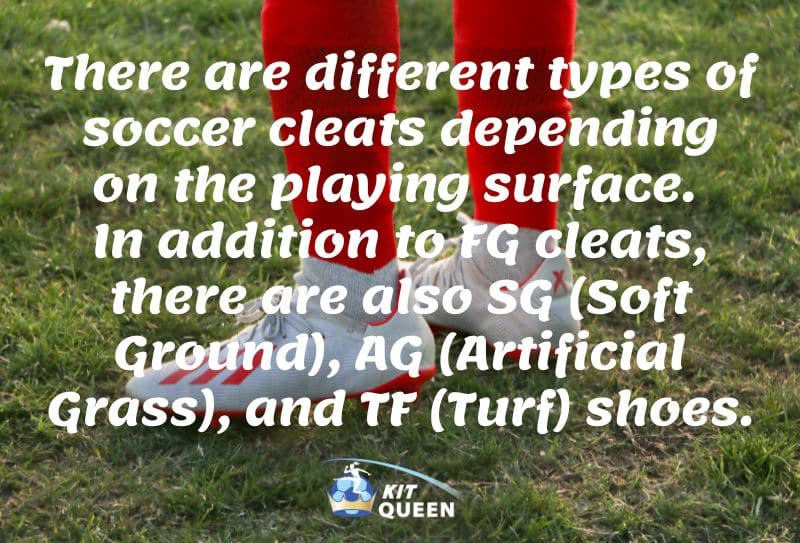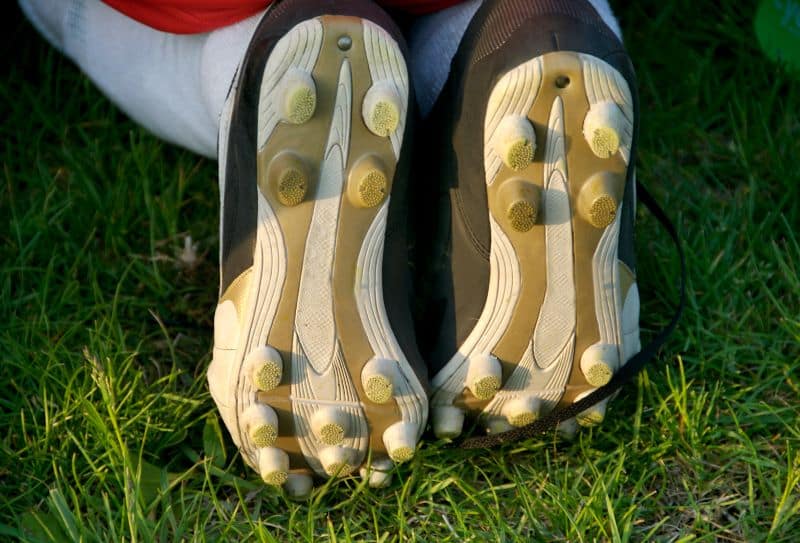If you’ve stepped foot on a soccer field, chances are you’ve noticed that there are different types of cleats. Some have metal spikes and are meant for grass fields, while others are turf shoes with small ridges.
And then there are FG cleats.
FG cleats have pointed studs that are placed in a specific configuration and they’re generally considered to be the best type of shoe for Firm Ground playing surfaces. But what does FG actually stand for?
We’re here with everything you need to know about the meaning of FG in soccer. Let’s kick off!
Table of Contents
- 1 What does FG stand for?
- 2 Different Types of Cleats
- 3 Can I wear FG cleats on turf?
- 4 Are AG or FG cleats better?
- 5 What happens if you wear FG cleats on AG?
- 6 Watch and learn: How to choose the right soles for soccer.
- 7 What does MG mean in soccer cleats?
- 8 What is the difference between soccer shoes and cleats?
- 9 The final score.
- 10 This article was written by
What does FG stand for?
FG stands for Firm Ground. Firm Ground cleats are designed for natural grass playing surfaces that may be slightly wet or dry.
The pointed studs on FG cleats provide good traction and allow you to change directions quickly on hard ground. If you’re playing on a muddy field, however, FG soccer cleats will likely not provide the best grip and you may want to consider wearing SG (soft ground) soccer cleats instead.

Different Types of Cleats
There are different types of soccer cleats depending on the playing surface. In addition to Firm ground cleats, there are also SG (Soft Ground) cleats, AG (Artificial Grass) cleats, and TF (Turf) shoes.
SG cleats are for soft ground surfaces. SG soccer cleats have longer, usually metal studs that are placed further apart from each other and they’re typically worn on wet, soft ground -like in the early spring months when the fields are still soggy from melted snow.
AG cleats, on the other hand, have shorter studs that are more closely spaced together and they’re meant for artificial ground and turf fieldes.
And finally, TF shoes have small rubber or synthetic turf spikes and they’re worn on turf fields that don’t have a lot of give to them.
TYPES OF FOOTBALL BOOTS
FG: FIRM GROUND
SG: SOFT GROUND
MG: MULTI-GROUND
AG: ARTIFICIAL GROUND
TF: ASTRO TURF
IC: INDOOR
Can I wear FG cleats on turf?
You can, but you probably don’t want to. The FG studs are designed for natural grass and they could damage the synthetic turf.
If you’re planning on playing on turf, it’s a good idea to check with your coach or league officials to make sure that FG cleats are allowed. Some leagues have rules about the type of cleats that can be worn on artificial turf, so it’s best to be sure before you boot up.
That said, many players find that FG cleats provide the perfect amount of traction and support for playing on turf, so they’re definitely worth a try if you’re looking for an alternative to traditional turf shoes.
In our expert opinion, it’s best to save yourself the hassle and save your FG cleats for when you’re playing on an actual grass field.
Are AG or FG cleats better?
It depends. If you’re playing on artificial turf, AG cleats will provide better traction and comfort. However, if you’re playing on natural grass, FG cleats are generally considered to be the better option.
If you’re trying to decide between AG and FG cleats, here are a few things to keep in mind:
AG cleats are designed for use on artificial turf, while FG cleats are meant for natural grass surfaces.
So, if you’re mostly playing on turf, AG cleats would be the better choice.
FG cleats tend to have longer and sharper studs that can provide better traction on slippery grass, but they can also cause more damage to the playing surface.
AG cleats usually have shorter studs that won’t do as much damage to the turf, but they may not provide as much grip.
Ultimately, it’s up to you to decide which type of cleat is best for your needs, just make sure they fit properly too!
What happens if you wear FG cleats on AG?
Well, the worst that can happen is that you damage the artificial turf.
The FG studs are designed for natural grass and they could tear up the synthetic turf. If you wear FG cleats on AG, you might not have quite as much traction as you’re used to. You’ll also find a lot of synthetic fieldes don’t allow FG cleats.
So, while you technically can wear FG cleats on AG, we don’t recommend it. It’s best to save your FG cleats for when you’re playing on natural grass.
Watch and learn: How to choose the right soles for soccer.
Here’s a great video that talks you through and shows you all the options out there when it comes to footwear on the field and how to choose the right fit soccer boot for you.
What does MG mean in soccer cleats?
MG stands for Multi Ground soccer cleats. These cleats have a combination of both metal and plastic studs that are designed to provide good traction on a variety of playing surfaces, including natural grass, artificial turf, and hard ground.
They’re a versatile option for players who need to be able to switch between different types of surfaces.
We love this type of boot because you can wear them for practice, games, and even just for kick-arounds with your friends. So if you’re looking for a cleat that can do it all, be sure to check out the latest MG models.
What is the difference between soccer shoes and cleats?
The main difference between soccer shoes and cleats is the type of sole they have. Soccer shoes have a flat sole with either metal or plastic spikes, while cleats have a raised sole with either metal or plastic spikes.
Both types of footwear are designed to provide traction and comfort while playing soccer.
Soccer shoes are generally lighter and have more padding to provide comfort during long games. They also have a smaller cleat on the sole of the shoe, which helps with movement but can make it harder to get traction on the field.
Cleats, on the other hand, are designed for maximum traction and speed. They have a larger cleat on the bottom of the shoe, which helps players to plant their feet firmly on the ground when making sharp turns.
In addition, cleats tend to be made of heavier materials to provide support during high-intensity play.
Each type of shoe has its own advantages and drawbacks – and mens soccer cleats are different to women’s too – that you’ll need to think about when choosing footwear for a game.
The final score.
Now that you know what FG soccer cleats are and why they’re beneficial, make sure to buy a pair before your next game! And if you’re ever unsure about what type of shoe to wear, just ask your coach or another player—chances are they’ll be able to help you out.



